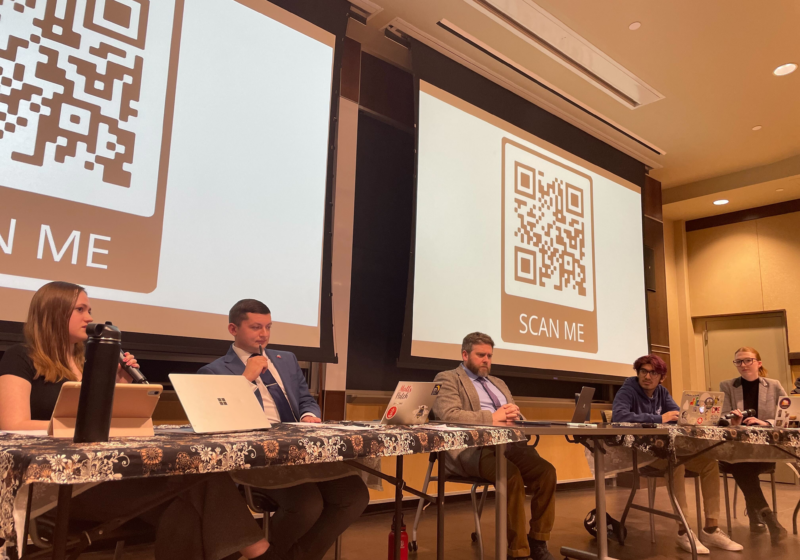The Students’ Association and the River Campus Libraries have begun to evaluate the costs of printing at the University to see what changes can be made to make printing more environmentally sustainable and cost effective for students.
‘We want students to pay for their own printing but we don’t want them to pay more than they should,” SA President and senior Eric Weissmann said.
The SA’s report released a few weeks ago focused on two points: promoting environmental sustainability and addressing the costs of printing at UR, in comparison to peer institutions.
Several suggested improvements to the printing system include incentives for double-sided printing and reducing the number of color printers.
According to the report, which included printing prices from 15 universities, the UR Copy Center and FedEx Kinko’s, UR has the highest prices for black and white and color.
One weakness to the report’s data, Weissmann and Assistant Dean of Information Technology Mike Bell mentioned, was that it did not account for fees that schools charge students to cover IT’s costs. It also did not account for the differences in printing features that UR has, such as printing from any station to any printer and color printing in all locations, that other schools may not have.
‘Different institutions are covering different portions of the cost,” Bell said. ‘The price is not necessarily reflecting the full cost of printing at every one of those different places.”
The Library set the current printing price, 10 cents per side for black and white and 60 cents per side for color, when it set up the printing network in 2004.
Printing on the River Campus was free before 2004, at that point, the system printed 10 million sheets per year.
Printing volume decreased from 10 million pages per year to 1 million pages per year, a 90 percent drop, when the Library started to charge.
Part of the reason that the school started to charge for printing was due to the significant environmental impact of printing millions more pages than were needed.
‘When printing was free people just hit the print button and never picked up the job at the end,” Vice Provost and Andrew H. and Janet Dayton Neilly Dean of River Campus Libraries Susan Gibbons said. ‘We had millions and millions of pages of printed paper that were just going into the recycling bin.”
That high volume of printing also had an effect on initial costs. When the network was created, printing staff knew that the number of pages would decrease and built a network that would handle a 50 to 75 percent reduction in volume.
Because the number of pages dropped by 90 percent, the network was designed to handle more pages and, therefore, cost more. This factor meant that the debt rose faster than expected.
‘The assumption on how the system would work was built around a volume that we haven’t gotten to,” Gibbons said.
The Library set the current prices to recover the starting costs of the printing network and pay for its maintenance costs.
‘Since there was no cost attached to it, students and faculty just hit the print button, not thinking that there was a cost both to paying for the printers and the paper and in the number of trees that we were destroying,” Gibbons said.
The initial investment in the printing system &- including the network software and licenses, printers, staff, paper and ink &- cost approximately $525,000. No funding was provided to cover these system costs. The Library incurred them entirely as debt and printing revenues were expected to pay down that debt.
‘Printing is not subsidized by anybody and the revenues from printing do not subsidize anything other than the cost of the system itself,” Gibbons said.
Since then, printing revenues have brought the debt from its initial $525,000 to $460,000 in March 2008 and lastly, down to $313,601 in February 2010.
At the current projected rate the Library may eliminate its debt in six years. That figure of six years excludes the costs of updating the network or buying new equipment.
So far, printing equipment has been fully replaced once, in 2008, and is expected to be replaced again in two years. Further, the servers, which have not been updated since the creation of the system, likely will have to be replaced.
New printers would add tens of thousands of dollars to the system’s debt and new servers would add more. Those additional costs would likely push the date for the system to break even to a decade or more.
‘There is no profit being made through the printing system at all,” Gibbons said. ‘It’s just trying to recoup costs, which are pretty extensive.”
To address concerns raised by the SA report, Weissmann, SA Sustainability Coordinator Megan DeWitt, Bell and Associate Vice Provost of Academic and Research Technology Eric Fredericksen met to discuss strategies and analyze the impacts of various pricing structures, including adding incentives for double-sided printing.
‘If the students prefer to charge on that structure on campus we should be able to do that,” Bell said. ‘We’re looking at that as an incentive for doing something for the environment versus doing it as a cost factor.” He added that an incentive for double-sided printing could be done in a budget-neutral way.
Moving to double-sided printing would have an additional cost. Printers on the River Campus all print double-sided.
At the UR Medical Center and the Eastman School of Music only some of the printers print double sided, so new equipment would have to be purchased.
‘They’re certainly not out to get anybody,” Weissmann said. ‘I think they want to work with us to look at our current offerings and see if some adjustments to pricing can be made.”
IT Center Manager Berthenia Coltrane said that she had not heard complaints from students about the cost of printing, only about technical problems.
‘The only time we have concerns is if there is a major outage and they can’t print,” Coltrane said.
Senior Phil Fleisher thought that current prices were reasonable because they encouraged students to use less.
‘It puts more value in getting things right the first time,” Fleisher said. ‘You know, measure twice, cut once.”
Senior Roger Hillson thought that the ideal system would be to allocate a certain number of pages to students per semester and charge them for additional pages.
‘People would actually look at it and say “I have this many left,'” Hillson said. ‘It would be like a dining plan.”
The Library is modeling different pricing structures to see how they would affect the bottom line. Those projections will then be presented to the College, which has the final decision on the financial end, and could change for the fall.
‘If everybody who is involved with this debt is comfortable with [it] not shrinking or staying where it is, we can propose this now and have discussions with the College dean so that this fall we can introduce a new pricing structure,” Gibbons said.
Fleming is a member of the class of 2010.




